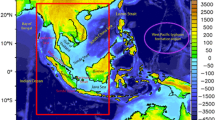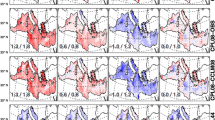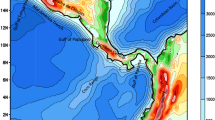Abstract
Climatological high resolution coupled climate model simulations for the maritime continent have been carried out using the regional climate model (RegCM) version 3 and the finite volume coastal ocean model (FVCOM) specifically designed to resolve regions characterized by complex geometry and bathymetry. The RegCM3 boundary forcing is provided by the EMCWF-ERA40 re-analysis. FVCOM is embedded in the Global MITgcm which provides boundary forcing. The domain of the coupled regional model covers the entire South China Sea with its through-flow, the entire Indonesian archipelago with the Indonesian through-flow (ITF) and includes a large region in the western Pacific and eastern Indian oceans. The coupled model is able to provide stable and realistic climatological simulations for a specific decade of atmospheric–oceanic variables without flux correction. The major focus of this work is on oceanic properties. First, the coupled simulation is assessed against ocean-only simulations carried out under two different sets of air–sea heat fluxes. The first set, provided by the MITgcm, is proved to be grossly deficient as the heat fluxes are evaluated by a two-dimensional, zonally averaged atmosphere and the simulated SST have anomalous cold biases. Hence the MITgcm fluxes are discarded. The second set, the NCEP re-analysis heat fluxes, produces a climatological evolution of the SST with an average cold bias of ~−0.8 °C. The coupling eliminates the cold bias and the coupled SST evolution is in excellent agreement with the analogous evolution in the SODA re-analysis data. The detailed comparison of oceanic circulation properties with the International Nusantara Stratification and Transport observations shows that the coupled simulation produces the best estimate of the total ITF transport through the Makassar strait while the transports of three ocean-only simulations are all underestimated. The annual cycle of the transport is also very well reproduced. The coupling also considerably improves the vertical thermal structure of the Makassar cross section in the upper layer affected by the heat fluxes. On the other hand, the coupling is relatively ineffective in improving the precipitation fields even though the coupled simulation captures reasonably well the precipitation annual cycle at three land stations in different latitudes.













Similar content being viewed by others
References
Aldrian E, Jacob D, Podzun R, Gates LD, Gunawan D (2004) Long term simulation of the Indonesian rainfall with the MPI regional model. Clim Dyn 22:795–814
Aldrian E, Sein D, Jacob D, Du¨menil Gates L, Podzun R (2005) Modeling Indonesian rainfall with a coupled regional model. Clim Dyn 25:1–17
Carton JA, Chepurin G, Cao X, Giese BS (2000a) A simple ocean data assimilation analysis of the global upper ocean 1950–1995, Part 1: methodology. J Phys Oceanogr 30:294–309
Carton JA, Chepurin G, Cao X (2000b) A simple ocean data assimilation analysis of the global upper ocean 1950–1995 Part 2: results. J Phys Oceanogr 30:311–326
Chen C, Liu H, Beardsley RC (2003) An unstructured, finite-volume, three-dimensional, primitive equation ocean model: application to coastal ocean and estuaries. J Atmos Oceanic Tech 20:159–186
Chen C, Beardsley RC, Cowles G (2006a) An unstructured grid, finite-volume coastal ocean model-FVCOM user manual, School for Marine Science and Technology, University of Massachusetts Dartmouth, New Bedford, Second Edition. Technical Report SMAST/UMASSD-06-0602, p. 318
Chen C, Beardsley RC, Cowles G (2006b) An unstructured grid, finite-volume coastal ocean model (FVCOM) system. Special issue entitled “advance in computational oceanography”. Oceanography 19(1):78–89
Fang G, Wang Y, Wei Z, Fang Y, Qiao F, Hu X (2009a) Interocean circulation and heat and freshwater budgets of the South China Sea based on a numerical model. Dyn Atmos Oceans 47:55–72
Fang Y, Zhang Y, Tang J, Ren X (2009b) A regional air-sea coupled model and its application over East Asia in the summer of 2000. Adv Atmos Sci. doi:10.1007/s00376-009-8203-7
Fang G, Susanto RD, Wirasantosa S, Qiao F, Supangat A, Fan B, Wei Z, Sulistiyo B, Li S (2010) Volume, heat and freshwater transports form the South China Sea to Indonesian seas in the boreal winter of 2007–2008. J Geophys Res 115:C12020. doi:10.1029/2010JC006225
Gan J, Li H, Curchitser EN, Haidvogel DB (2006) Modeling South China Sea Circulation: response to seasonal forcing regimes. J Geophys Res 111:C06034. doi:10.1029/2005JC003298
Gianotti RL, Zhang D, Eltahir EAB (2012) Assessment of the regional climate model version 3 over the maritime continent using different cumulus parameterization and land surface schemes. J Climate 25:638–656. doi:10.1175/JCLI-D-11-00025.1
Giorgi F, Marinucci MR, Bates GT (1993) Development of a second-generation regional climate model (RegCM2). Part I: boundary-layer and radiative transfer processes. Mon Wea Rev 121:2794–2813
Gordon AL (2005) Oceanography of the Indonesian seas and their through-flow. Oceanography 18(4):14–27
Gordon AL, McClean JL (1999) Thermohaline stratification of the Indonesian Seas: model and observations. J Phys Oceanogr 29:198–216
Gordon AL, Susanto RD, Ffield A, Huber BA, Pranowo W, Wirasantosa S (2008) Makassar Strait throughflow, 2004 to 2006. Geophys Res Lett 35:L24605. doi:10.1029/2008GL036372
Gordon AL, Sprintall J, Van Aken HM, Susanto D, Wijffels S, Molcard R, Ffield A, Pranowo W, Wirasantosa S (2010) The Indonesian throughflow during 2004–2006 as observed by the INSTANT program. Dyn Atmos Oceans 50:115–128. doi:10.1016/j.dynatmoce.2009.12.002
Gordon AL, Huber BA, Metzger EJ, Susanto RD, Hurlburt HE, Adi TR (2012) South China Sea throughflow impact on the Indonesian throughflow. Geophys Res Lett 39:L11602. doi:10.1029/2012GL052021
Grell GA, Dudhia J, Stauffer DR (1994) Description of the fifth generation Penn State/NCAR Mesoscale Model (MM5), Technical Report TN-398 + STR. National Center for Atmospheric Research, Boulder
Gualdi S, Somot S, Li L, Artale V, Adani M, Bellucci A, Braun A, Calmanti S, Carillo A, Dell’Aquilla A, Déqué M, Dubois C, Elizalde A, Harzallah A, Jacob D, Lheveder B, May W, Oddo P, Ruti P, Sanna A, Sannino G, Sevault F, Scoccimarro E, Navarra A (2012) The CIRCE simulations: a new set of regional climate change projections performed with a realistic representation of the Mediterranean Sea. Bull Amer Meteor Soc. doi:10.1175/BAMS-D-11-00136.1
Hill C, Marshall J (1995) Application of a parallel Navier-Stokes model to ocean circulation in parallel computational fluid dynamics In: Proceedings of parallel computational fluid dynamics: implementations and results using parallel computers, pp 545–552
Holtslag AAM, de Bruijn EIF, Pan H-L (1990) A high-resolution air mass transformation model for short-range weather forecasting. Mon Wea Rev 118:1561–1575
Huffman GJ, Adler RF, Bolvin DT, Gu G, Nelkin EJ, Bowman KP, Hong Y, Stocker EF, Wolff DB (2007) The TRMM multi-satellite precipitation analysis: quasi-global, multi-year, combined-sensor precipitation estimates at fine scale. J Hydrometeor 8:38–55
Kalnay E, Kanamitsu M et al (1996) The NCEP/NCAR 40-year Reanalysis Project. Bull Amer Meteor Soc 77:437–471
Kiehl JT, Hack JJ, Bonan GB, Boville BA, Breigleb BP, Williamson DL, Rasch PJ (1996) Description of the NCAR Community Climate Model (CCM3), NCAR Technical Note TN-420 + STR, [Available online at: http://www.cgd.ucar.edu/cms/ccm3/TN-420/]
Levitus S, Antonov JI, Boyer TP, Stephens C (2000) Warming the world ocean. Science 287:2225–2229
Levitus S, Antonov JI, Boyer TP (2005) Warming of the World Ocean, 1955-2003. Geophys Res Lett 32:L02604. doi:10.1029/2004GL021592
Li T, Zhou GQ (2010) Preliminary results of a regional air-sea coupled model over East Asia. Chinese Sci Bull 55:2295. doi:10.1007/s11434-010-0071-0
Marshall J, Hill C, Perelman L, Adcroft A (1997) Hydrostatic, quasi-hydrostatic, and nonhydrostatic ocean modeling. J Geophys Res 102(C3): 5733–5752
Mellor GL, Yamada T (1982) Development of a turbulence closure model for geophysical fluid problem. Rev Geophys Space Phys 20:851–875
Pal JS et al (2007) Regional climate modeling for the developing world: the ICTP RegCM3 and RegCNET. Bull Am Meteorol Soc 88:1395–1409
Qu T, Song YT, Yamagata T (2009) An introduction to the South China Sea through-floe: its dynamics, variability and application for climate. Dyn Atnos Oceans 47:3–14
Rayner NA, Horton EB, Parker DE, Folland CK, Hackett RB (1996) Version 2.2 of the global sea-ice and sea-surface temperature data set, 1903–1994. Technical Note CRTN74. Clim Res p 35
Ren X, Qian Y (2005) A coupled regional air–sea model, its performances and climate drift in simulation of the east Asian summer monsoon in 1998. Int J Climatol 25:679–692
Smagorinsky J (1963) General circulation experiments with the primitive equations, I. The basic experi-ment. Mon Wea Rev 91:99–164
Sprintall J, Wijffels S, Molcard R, Jaya I (2009) Direct estimates of the Indonesian throughflow entering the Indian Ocean: 2004-2006. J Geophys Res 114:C7. doi:10.1029/2008JC005257
Susanto RD, Ffield A, Gordon AL, Adi TR (2012) Variability of Indonesian throughflow within Makassar Strait, 2004–2009. J Geophys Res 117:C0913. doi:10.1029/2012JC008096
Terray L, Valcke S, Piacentini A, 1999: OASIS 2.3 Ocean atmosphere sea ice soil user’s guide. Technical Report TR/CGMC/99-37 CERFACS p 82
Tillinger D, Gordon AL (2010) Transport weighted temperature and internal energy transport of the Indonesian throughflow. Dyn Atmos Oceans 50:224–232
Uppala SM et al. (2005) The ERA-40 Re-Analysis. Q J R Meteorol Soc 131:2961–3012. [Dataset available online at: http://www.ecmwf.int/research/era/do/get/era-40]
Valcke S, Terray L, Piacentini A (2000) The OASIS Coupler User’s Guide, Version 2.4. Technical Report TR/CGMC/00-10 CERFACS, p 85
Xu D, Malanotte-Rizzoli P (2013) Seasonal variation of the upper layer of the South China Sea and the Indonesian Seas: an Ocean Model Study. Dyn Atmos Oceans 63:103–130. doi:10.1016/j.dynatmoce.2013.05.002
Zeng X, Zhao M, Dickinson RE (1998) Intercomparison of bulk aerodynamic algorithms for the computation of sea surface fluxes using TOGA COARE and TAO data. J Climate 11:2628–2644
Zou L, Zhou T (2011) Sensitivity of a regional ocean-atmosphere coupled model to convection parameterization over western North Pacific. J Geophys Res 116:D18106. doi:10.1029/2011JD015844
Acknowledgments
This study was supported by the Singapore National Research Foundation (NRF) through Center for Environmental Sensing and Monitoring (CENSAM) under the Singapore-MIT Alliance for Research and Technology (SMART) program and by National Natural Science Foundation of China (NSFC, No. 41106003).
Author information
Authors and Affiliations
Corresponding author
Rights and permissions
About this article
Cite this article
Wei, J., Malanotte-Rizzoli, P., Eltahir, E.A.B. et al. Coupling of a regional atmospheric model (RegCM3) and a regional oceanic model (FVCOM) over the maritime continent. Clim Dyn 43, 1575–1594 (2014). https://doi.org/10.1007/s00382-013-1986-3
Received:
Accepted:
Published:
Issue Date:
DOI: https://doi.org/10.1007/s00382-013-1986-3




